LDUBS
Well-known member
- Joined
- Aug 14, 2016
- Messages
- 6,746
- Reaction score
- 3,639
- Location
- Northern California
- LOCATION
- Northern California
Definitely not epoxying transom the the hull skin. No sir, there was no inner aluminum skins in the transom wood. Just the hull. My thinking is that if I bond 14-16 gauge aluminum to either side of the new transom wood, it will help distribute the load more evenly and prevent clamps, rivets, ect from opening the wood to moisture. The may be a 25 HP hanging off of it in the future.
I see your thinking here. I wonder if structural gains from encapsulating both sides is significant. Added weight would be pretty low. In my mind, like @thill says, adhering a skin to the inner (forward) side of the wood transom is good. I may be missing a significant benefit to adhering aluminum sheet to the back (transom) side too. I would do it if I wanted to. No one ever went wrong from overbuilding a transom!





















































